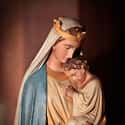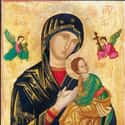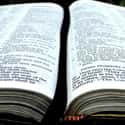-
(#6) The Apocrypha Bridge The Years Between The Testaments
The Apocrypha are a collection of books and stories written in the years between the completion of the Old Testament and the first books of the New Testament. Those writings have enough religious value that scholars felt they deserved a place in canon. For various reasons, these were left or cut out of the Bible in order to preserve a narrative or consistent values.
Parts of the Apocrypha have popped in and out of versions of the Bible since 405 CE, but the 1455 Gutenberg Bible is considered to be the first printing of the book to include the chapters mixed into the text. It wasn't until 1534 that Martin Luther printed a version of the book with a separate section for the Apocrypha, thus acknowledging the politicization of the religious texts and giving believers a chance to find new stories of fulfillment.
The largest impact of the Apocrypha may be a verse from the Book of Esdras, which Columbus said inspired him to journey across the Atlantic. "Six parts of the earth are habitable, and the seventh is covered in water."
-
(#1) The Gospel Of Mary Of Magdala Doesn't Fit With The Rest Of The Bible, So It Doesn't Get Included
The Gospel of Mary Magdalene is an apocryphal text that Biblical scholars really don't want to include in the Bible—not because it was written in the 2nd or 3rd century (plenty of books in the Biblical canon weren't even finished until the 2nd century), but because it offers a different take on spiritualism than the rest of the books.
In this book, Mary describes a discussion she has with Jesus and the disciples where Jesus explains that people have a spirit, a mind, and a second spirit that connects them with God. Many Biblical scholars believe that by adding this book to the Bible, the message of the book would be convoluted with conflicting philosophies that would teach people to find an inner harmony, rather than only to seek salvation from a higher power.
-
(#8) The Non-Confrontational Jesus In The Gospel Of John Was Probably Added Later
Whether you're a believer or not, you probably know the phrase, "Let he who is without sin cast the first stone." It's one of Jesus' most quoted lines. But are those his words? In 2007, when studying New Testament manuscripts, Dallas Theological Seminary professor Daniel Wallace noticed that the memorable story of Jesus defending an adulterous woman was missing from the earliest and most reliable manuscripts. Many Bible scholars agree that these verses (usually found in John 7:53-8:11) are not original to John's Gospel. Those words were added sometime around the 5th century.
There is debate as to whether this story should still be considered Scripture at all. On one hand, all of the stories about Jesus began orally, and this story could have actually occurred only to be written down much later. On the other hand, this story causes problems for scholars trying to draw the line between what should be considered canonical text and what shouldn't.
-
(#13) No One Can Agree On How Many People Wrote Judges
Judges existed in a variety of forms before it was edited into the book in the Bible. First, it was simply a collection of stories about Ehud and Jael going around and judging people, with a few excerpts from Gideon to spice it up. Over time, more stories were added to the text to beef up the story before finally being retrofitted into Deuteronomy.
Until the 20th century, most scholars assumed that the stories were all written by various authors, but in the early '80s, Martin Noth came to the conclusion that Judges was written by a single author who was in exile, which he believes accounts for the many discrepancies found throughout Judges and the Deuteronomistic texts. If Noth's assumption is correct, then it could reframe hundreds of years of Biblical research.
-
(#7) We Should Probably Throw Luke Out Since It's Such A Pieced-Together Amalgamation
Though there's no book in the Bible that hasn't been severely edited, there may not be one that's as inconsistent in its revisions as Luke. Today, we know Luke is actually an amalgamation of the Western and the Alexandrian versions of the text. To further complicate matters, a third version of Luke exists that was written by a 2nd-century heretic who made his own version of Luke that somehow got mixed into the scripture.
-
(#12) Mark Blends The Greatest Hits Of Other Stories To Create A Cohesive Narrative About Jesus
Up until the early 20th century, Mark was considered to be the most historically accurate version of the events of Jesus' life, but between 1901 and 1919, two different historians, William Wrede and Karl Ludwig Schmidt, showed that Mark was a theological construct that had been rebuilt with variant verses to form the best theological version of events.
One of the biggest clues that the story was too good to be true was the idea that so many of Jesus' classic stories could be tied together in such a clean narrative. Biblical historians prior to the 20th century either ignored this fact or they simply didn't want to recognize that the story had been heavily altered and edited after its initial writing in order to tell a more coherent story.
New Random Displays Display All By Ranking
About This Tool
The Christian Bible is composed of "Old Testament" and "New Testament". The Old Testament has 39 volumes, written in ancient Hebrew and compiled according to the teachings of Judaism, it covers the humanities and historical data of the Jewish and neighboring nations from the 12th century BC to the 2nd century BC. There are 27 volumes in the "New Testament". Christianity has gone through thousands of years of development and transformation.
Devout believers have made continuous efforts to protect the original doctrines and even adopted many extreme protection methods. The Bible has been revised and translated many times over the centuries in order to meet the requirements of the times. The random tool explained 14 details about the differences of the original Bible.
Our data comes from Ranker, If you want to participate in the ranking of items displayed on this page, please click here.
















